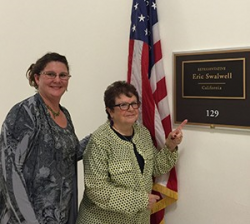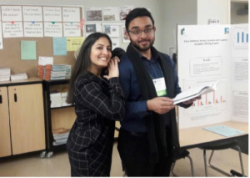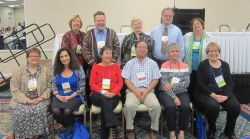|
CATESOL’s History
CATESOL, which started in 1969, was always at the forefront of
TESOL affiliates in the U.S. Owing to the large size of the state and
its growing and highly diverse population, the founders of our
organization quickly realized that one meeting per year would not serve
the large number of teachers and graduate students who needed the
expertise that CATESOL mentors could offer. Gloria Jameson, the first
president of CATESOL, held initial meetings in both Los Angeles and
Monterey (the location of the Defense Language Institute). CATESOL has
grown and the map shown below lists the current number of chapters in
California and the Northern and Southern divisions of Nevada. What
follows is a brief history of CATESOL by the decade. As of late 2018,
Nevada ESL professionals have formed their own TESOL affiliate
(nvtesol.org)
Map of CATESOL chapters
The 70s
CATESOL conferences were first called “minis.” By 1971, these
mini conferences had soon morphed into northern and southern conferences
held roughly two weeks apart in November. By 1975, attendance had
almost doubled with conferences held in both San Francisco and Long
Beach. CATESOL decided to expand to five regional conferences (L.A., the
Bay Area, Orange County, Fresno, and Ventura County). In September of
1974, a Nevada Committee was added to address the needs of our
neighboring state.
Much like the states of New York and Texas, California
experienced a large influx of immigrant students into the different
levels of state-funded education (K-12, community college, and
university systems). TexTESOL set up numbered regions due to the large
size of the state. California chose geographic names that reflected
either a county or a larger area. By November of 1975, CATESOL had 15
regions as well as a committee for Nevada. The chairs and assistant
chairs of these regional groups met both locally and at the annual state
conference. In large metropolitan areas such as Los Angeles County,
local chapters were formed.
The 80s
CATESOL continued to grow in the 1980s as refugees from wars
and poverty sought better lives for themselves and their families. From
1984 to 85, three more chapters were added (Nevada, Orange County, and
Sacramento) and in 1988 the CATESOL Board approved the creation of theCATESOL Journal. This academic publication had previously been a series
of Occasional Papers.
The 90s
The waves of immigration spilled over from the late 80s to the
early and mid-90s. More colleges and universities added TESOL MA and
certificate programs. With more ESL professionals getting jobs in the
field, it became necessary to support and represent the various
professional academic concerns of the CATESOL membership. Thus, Interest
Groups were added. In 1988, the Intercultural Communication and TELL
(Technology Enhanced Language Learning) Groups were added. The following
year saw the addition of both the Teaching English in the Workplace
Group and the Non-native Language Educators Issues Group.
The 2000s
The 2000s brought more changes initiated at both the state and
national level. CATESOL needed to keep up with new legislation that had
an impact on students, teachers, and school funding, so Jeff Frost was
hired as CATESOL’s Legislative Advocate in 2000 to keep members informed
about issues related to teaching English language learners and to make
the needs of our students clear to our legislators. CATESOL is unique in
that it represents teachers of English to non-native speakers at every
level and type of educational setting. A full list of the current board
positions may be found at catesol.org.
CATESOL also sends representatives to Washington once a year to
meet with U.S. legislators to put forth the concerns of ESL teachers in
California and Nevada. 
CATESOL Past President Sydney Rice and K-12 Advocacy
Chair Judy O’Loughlin visit Rep. Eric Swalwell’s office in Washington
D.C.
CATESOL is a 501(c)(3) non-profit organization (501-c-3), so
there are certain limits on what such an organization may fund, and it
may not use the majority of its funds to influence legislation. The
CATESOL Educational Foundation was formed in 2006 in order to fund
projects and events. Some of these projects have included funding
speakers for the annual conference, sponsoring training workshops, and
establishing a Regional Stipend Fund to help students attend regional
conferences.

2016 Rick Sullivan Stipend Awardee Ninet Aghasarourian
with 2017 Regional Stipend Awardee John Pervez
Funding was for this foundation was provided by the estate of
Dr. Sumako Kimizuka, a professor of Japanese and Linguistics at the
University of Southern California (USC) and a long-time advocate for ESL
students. Dr. Kimizuka had learned English in Japan prior to moving to
California for graduate studies and mentored many Linguistics and ESL
students during her long career. Karen Dennis and Dan Fichtner
spearheaded the effort to create the foundation with this funding along
with a group of dedicated volunteers.

John Liang, the 2016 winner of the Sadae Iwataki
award, sitting in front row with ten past award winners.
The 2010s
The current climate is more challenging. There is more of an
emphasis on testing at every level of education. Colleges and
universities in California have felt the effects of increased scrutiny
by accrediting agencies. Adjunct teachers have had to deal with class
reductions. The current trend of moving students out of ESL classes and
into Freshman Writing sooner is one that bears watching.
The good news is that many CATESOL members have worked
tirelessly to help amend legislation to protect both teachers and
students. Assembly Bill 705 could have limited ESL instruction to one
level below transfer-level English. Instead, the bill now allows a
three-year timeframe. More significantly, California law now codifies
that ESL instruction is “distinct from remediation in English” and that
students enrolled in ESL coursework are foreign language learners.” This
makes a big difference for students who are seeking financial aid and
to adjunct teachers looking for more classes. Administrators can better
plan for future budgets and class scheduling. The story will continue
since ESL programs will have until Fall 2020 to comply with the
provisions of AB 705.
DACA
CATESOL sent a letter and a white paper to state congressional
representatives explaining the impact that new legislation would have on
DACA students. CATESOL sent an email to membership describing how to
contact federal legislators to request that opportunities for DACA
students be restored.
Publications
In addition to the CATESOL Journal, CATESOL offers a website
with access to articles, a job bank, information on recent legislation
and opportunities to volunteer and mentor. This is a far cry from the
stapled newsletter that was mailed to members in the 1970s.
What CATESOL Has Meant to Some Recent Past Presidents
Gretchen Bitterlin (1995-96)
When I started teaching ESL in 1972, I knew nothing about
actually teaching ESL, so I went to a CATESOL Regional conference to
learn what to do in the classroom. CATESOL’s professional development
was vital, so I never missed a Regional or State conference after that. I
received leadership training through serving as the Adult Level Chair
and as CATESOL President. This gave me the confidence to serve in
leadership positions within my program at San Diego Continuing
Education. One of the things I am most proud of is the political work we
did through CATESOL to pass a ‘No” vote on Proposition 187, which would
have discriminated against immigrants. The battle continues to protect
immigrant rights, and CATESOL can be a powerful force in fighting that
battle.
Kara Rosenberg (1996-97)
I owe much of my leadership career to CATESOL. I believe that
participating in professional organizations is an important part of a
career. One of the things that struck me the most as I went through
several CATESOL offices was the importance of sociopolitical work. I was
uneasy about jumping into the politics of helping our students and
other immigrants, but through participation, I came to realize the
importance of working for appropriate educational legislation and for
protecting the rights of immigrants. We need to immerse ourselves in
this work because it seriously affects our students and their families.
Legislators need our input and working through a professional
organization increases our influence.
Kathleen Flynn (2008-09)
I joined CATESOL in 1980. I was a new grad student at USC and
my professors told me that this organization would make a difference in
my life. I saw former students returning to put on conferences and they
told me how their experiences volunteering with CATESOL had helped them
to make contacts in the field that led to jobs. I attended my first
state conference in 1980 and realized that this was the organization for
me. Over the years, I have met many people whom I now call friends and I
look forward to the annual conference as a time to reconnect and to
keep current in the field.
Belinda Braunstein (2009-10)
I’ll never forget when I joined the CATESOL board mid-year as a
new Chapter Chair in the late 1990s, replacing a person who moved away.
I had no idea what to expect at my first big state board meeting, and I
didn’t know a soul. Everyone was so kind. Two people came up to me at
different times to welcome me and answer my many questions. I knew right
away that this was a great organization that I would become active
in.
Lynne Díaz-Rico (2010-11)
At every CATESOL conference over the years, whether a local,
regional, or the annual, I have reconnected with colleagues I rarely see
in person (California is a big state!), made new friends, attended
terrific presentations, and acquired new technology skills. I have my
own favorite presenters that I seek out time and again--these have been
my teachers over the years. I always try to contribute as well. This
year I made my 50th CATESOL academic presentation. Many thanks to those
colleagues who have supported me as I have grown and matured in this
profession!
Ellen Lange (2014-15)
When I decided to teach ESL/EFL instead of French, Gwendolyn T.
Schwabe, aka Tippy, a CATESOL icon, taught my very first teacher
training class. Our class attended the Northern Regional at the
University of San Francisco. Once there, I was captivated by the
colorful ribbons hanging on name tags and said to myself, “I want one of
those.” To reach my goal of “that ribbon,” I taught, care gave for my
husband, and studied for my M.A. in TESOL at CSU—Sacramento, all at the
same time. And I had started presenting before I finished my degree. My
“collection” progressed to a CATESOL Board ribbon when I became College
and University Chair. Along the way, I also wore Conference Committee
and Conference Chair ribbons. In 2012, Tippy Schwabe “urged” me to run
for President. I was retired by then but wanted to continue service. I
never forgot my primary goal which was to promote all levels of
instruction and encourage instructors to learn from one another as I
firmly believe we are pieces of a much larger puzzle. I treasure my time
in service to CATESOL and just agreed at the 2018 Annual to become the
TOP Co-coordinator for 2018-19 and wear yet another ribbon.
Thanks to K. Lynn Savage for sharing the outline of her presentation on the history of CATESOL.
Kathleen Flynn taught ESL at the community college and
university levels and was the Series Editor for the Panorama reading
series. | 
